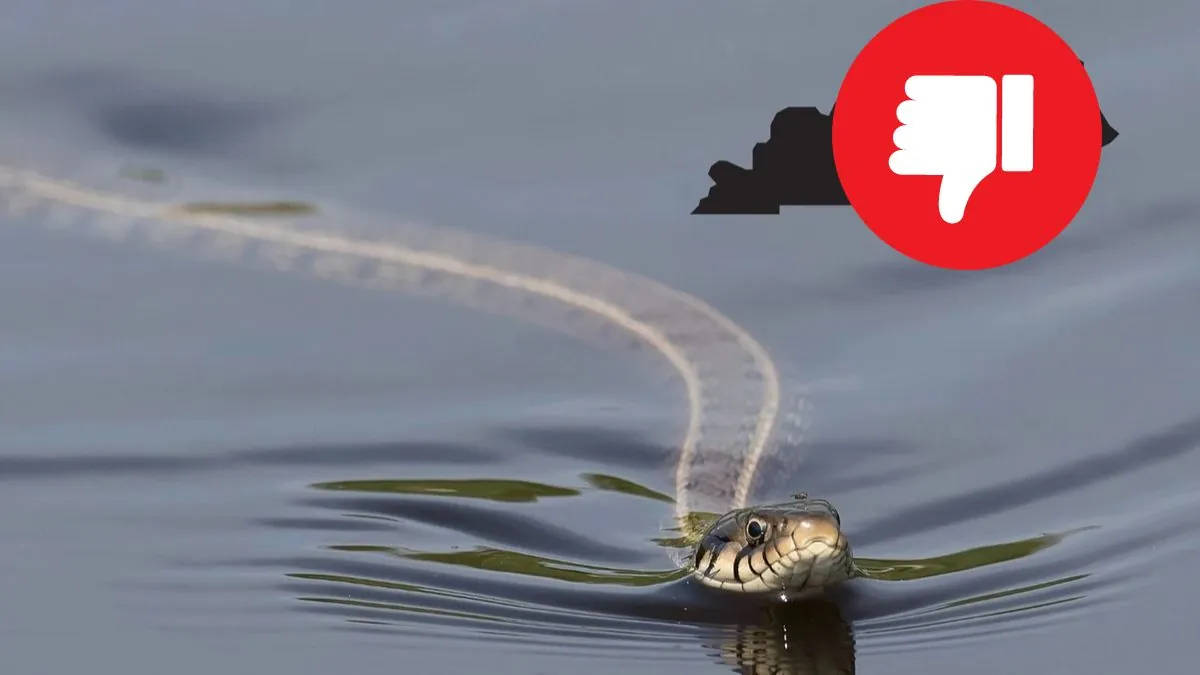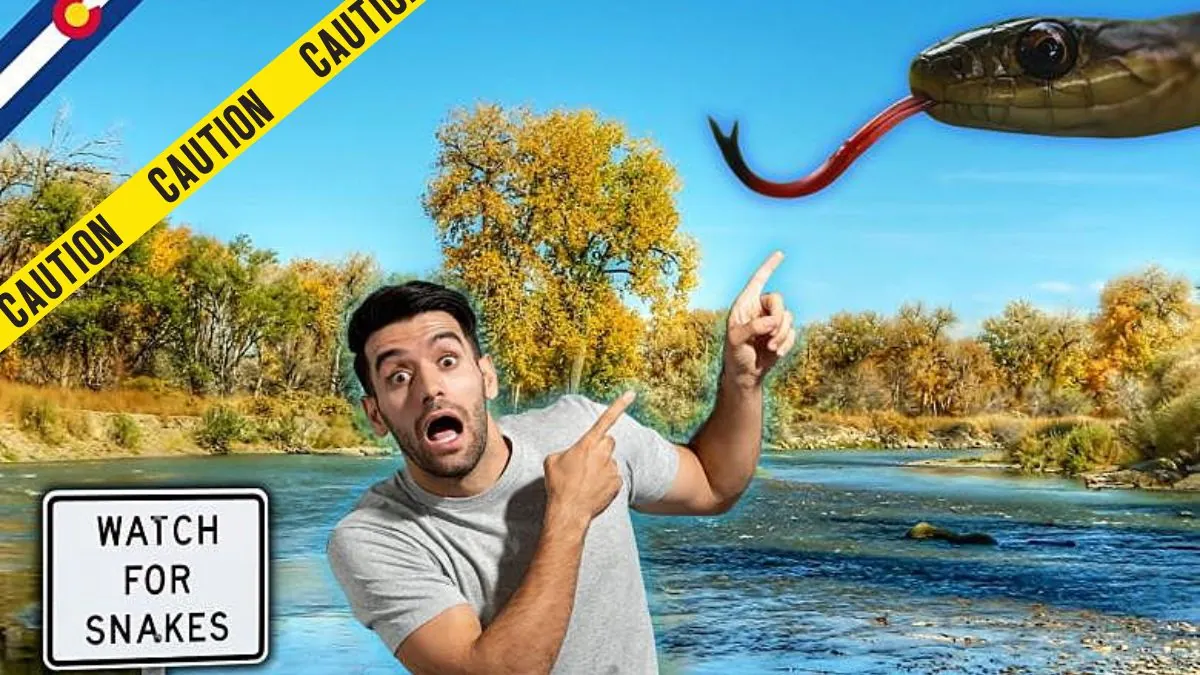Virginia, with its rich ecosystems and diverse wildlife, is a state where nature enthusiasts find a haven. From the Blue Ridge Mountains to the Chesapeake Bay, Virginia’s natural beauty is captivating. However, for those with ophidiophobia—or fear of snakes—some of Virginia’s water bodies might be less inviting. Snakes are an essential part of the ecosystem, and their presence in lakes and rivers is a sign of a healthy environment. That said, certain lakes in Virginia are more notorious than others for being snake hotspots. In this article, we will explore the top five most snake-infested lakes in Virginia as of 2024, providing an in-depth look at each location, the types of snakes you might encounter, and tips for staying safe.
Virginia is home to 32 species of snakes, of which only three are venomous: the Eastern Copperhead, the Timber Rattlesnake, and the Cottonmouth (also known as the Water Moccasin). The majority of Virginia’s snake species are non-venomous and play crucial roles in controlling pest populations, such as rodents and insects. Despite their benefits, the mere presence of snakes can be unsettling for many people, especially when they are encountered in places where humans enjoy outdoor activities, such as lakes.
The state’s diverse geography, ranging from coastal plains to mountainous regions, provides ideal habitats for various snake species. Wetlands, forests, and bodies of water are particularly attractive to snakes, offering abundant food sources and shelter. While snakes are generally shy and prefer to avoid human interaction, the increasing overlap between human activities and natural habitats has led to more frequent encounters.
Factors Contributing to Snake Infestations in Lakes
Several factors contribute to the prevalence of snakes in certain lakes. Understanding these factors can help explain why some lakes have higher snake populations than others.
Environmental Factors
- Climate: Virginia’s warm and humid climate, especially during the summer months, creates an ideal environment for snakes. Snakes are ectothermic (cold-blooded) animals, meaning they rely on external heat sources to regulate their body temperature. Lakes and surrounding areas provide ample sunning spots for snakes to warm themselves, as well as cool water to escape the heat.
- Vegetation: Dense vegetation around lakes, including forests, marshes, and aquatic plants, offers snakes plenty of cover and hunting grounds. This vegetation also supports a rich diversity of prey, including fish, amphibians, and small mammals, which attract snakes.
- Prey Availability: Lakes with abundant food sources tend to have higher snake populations. For example, lakes with healthy fish populations are likely to attract water snakes, while lakes surrounded by forests might attract species that feed on rodents and birds.
Human Factors
- Land Use: Urbanization and land development can disrupt natural habitats, forcing snakes to relocate to more favorable environments like lakes. In some cases, human activities such as fishing and boating inadvertently provide food sources (e.g., fish remains) that attract snakes.
- Pollution: Pollution can alter the natural balance of ecosystems, sometimes leading to an increase in certain snake populations. For example, if pollution reduces the number of snake predators, snake populations may rise unchecked.
- Conservation Efforts: In some areas, conservation efforts aimed at preserving natural habitats can lead to an increase in snake populations. Protected areas around lakes often serve as refuges for wildlife, including snakes.
Top 5 Most Snake-Infested Lakes in Virginia
Now, let’s dive into the top five most snake-infested lakes in Virginia in 2024. These lakes are known for their high snake populations, and while they are beautiful and offer plenty of recreational opportunities, visitors should be aware of the potential for snake encounters.
Smith Mountain Lake
Located in the Blue Ridge Mountains of southwest Virginia, Smith Mountain Lake is the state’s second-largest freshwater body, covering over 20,000 acres. The lake is a popular destination for boating, fishing, and water sports, attracting thousands of visitors each year.
- Snake Infestation: Smith Mountain Lake is particularly known for its large population of Northern Water Snakes, which are often seen basking on rocks or swimming near the shoreline. These non-venomous snakes can grow up to four feet long and are often mistaken for the venomous Cottonmouth due to their similar appearance. However, Northern Water Snakes are not dangerous to humans, although they can be aggressive if provoked.
- Visitor Tips: To avoid snake encounters, stick to well-maintained trails and avoid tall grass and rocky areas where snakes are likely to hide. If you spot a snake, give it plenty of space and do not attempt to handle it.
Lake Anna
Lake Anna, located in central Virginia, is one of the state’s largest lakes, covering over 13,000 acres. It is a popular spot for fishing, particularly for largemouth bass, and is also frequented by boaters and swimmers.
- Snake Infestation: Lake Anna is home to a variety of snake species, including the Eastern Garter Snake and the Eastern Rat Snake. The lake’s warm waters and abundant shoreline vegetation make it an ideal habitat for these snakes. Additionally, Lake Anna is known to have a smaller population of Copperheads, a venomous species that prefers wooded areas near water.
- Visitor Tips: Be cautious when exploring wooded areas around the lake, especially during the warmer months when snakes are more active. Wearing long pants and boots can help protect you from snake bites.
Lake Drummond
Lake Drummond, one of only two natural lakes in Virginia, is located in the heart of the Great Dismal Swamp, a vast, ecologically rich wetland that straddles the Virginia-North Carolina border. The lake covers approximately 3,100 acres and is known for its mysterious, dark waters.
- Snake Infestation: The Great Dismal Swamp is home to a significant population of Cottonmouths, making Lake Drummond one of the most snake-infested lakes in the state. Cottonmouths, also known as Water Moccasins, are venomous snakes that are often found near or in water. They are known for their distinctive white mouths, which they display when threatened.
- Visitor Tips: Exercise extreme caution when visiting Lake Drummond, especially if you plan to kayak or canoe in the swampy areas. Avoid reaching into the water or vegetation without checking for snakes first. If you encounter a Cottonmouth, do not approach it; instead, slowly back away and give it plenty of space.
Kerr Lake (Buggs Island Lake)
Kerr Lake, also known as Buggs Island Lake, is a large reservoir on the border between Virginia and North Carolina. Covering over 50,000 acres, it is the largest lake in Virginia and is a popular destination for fishing, camping, and boating.
- Snake Infestation: Kerr Lake is known for its diverse snake population, including both non-venomous species like the Eastern Rat Snake and venomous species like the Copperhead. The lake’s vast shoreline, marshes, and wooded areas provide ideal habitats for these snakes. The presence of rodents and other prey in the surrounding forests also attracts snakes to the area.
- Visitor Tips: When camping or hiking near Kerr Lake, be mindful of where you step and place your hands. Snakes often hide under logs, rocks, and debris, so it’s important to be cautious. Keep your campsite clean and store food securely to avoid attracting rodents, which can, in turn, attract snakes.
Lake Gaston
Lake Gaston is another large reservoir that straddles the Virginia-North Carolina border, covering approximately 20,000 acres. It is a popular recreational spot known for its clear waters, making it a favorite for swimming, boating, and fishing.
- Snake Infestation: Like Kerr Lake, Lake Gaston is home to a variety of snake species, including the Northern Water Snake, the Eastern Garter Snake, and the occasional Copperhead. The lake’s clear waters and sandy beaches might seem less likely to harbor snakes, but the surrounding vegetation and marshy areas are prime snake habitats.
- Visitor Tips: While swimming or boating, be mindful of snakes that might be resting on floating debris or near the shore. If you’re fishing, be cautious when reaching into the water or handling fish, as snakes might be attracted to the commotion.
Snake Species Commonly Found in These Lakes
Understanding the types of snakes you might encounter at these lakes can help you identify and react appropriately to a snake sighting. Here are some of the most common snake species found in Virginia’s lakes:
Non-Venomous Snakes
- Northern Water Snake (Nerodia sipedon): Often mistaken for the Cottonmouth due to its similar coloration, the Northern Water Snake is non-venomous and typically found near water. It feeds on fish and amphibians and is known for its aggressive behavior when threatened.
- Eastern Garter Snake (Thamnophis sirtalis): A common snake across Virginia, the Eastern Garter Snake is easily recognizable by its striped pattern. It is non-venomous and poses no threat to humans, often found near water where it feeds on small fish and amphibians.
- Eastern Rat Snake (Pantherophis alleghaniensis): This large, non-venomous snake is often found in wooded areas near lakes. It is an excellent climber and primarily feeds on rodents, birds, and eggs. Despite its size, it is harmless to humans.
Venomous Snakes
- Cottonmouth (Agkistrodon piscivorus): Also known as the Water Moccasin, the Cottonmouth is a venomous snake commonly found in wetlands, swamps, and lakes in Virginia. It is known for its defensive behavior, including opening its mouth to reveal a white interior when threatened. While not aggressive, it can deliver a painful and potentially dangerous bite if provoked.
- Copperhead (Agkistrodon contortrix): The Copperhead is another venomous snake found in Virginia, often in wooded areas near water. It is known for its distinctive copper-colored head and hourglass-shaped markings on its body. Copperheads are generally not aggressive but will bite if threatened.
Safety Tips for Visitors to Snake-Infested Lakes
Encountering a snake while enjoying Virginia’s lakes can be a startling experience, but with the right knowledge and precautions, you can stay safe. Here are some tips to help you avoid snake bites and stay safe while exploring these areas:
- Identify and Avoid: Learn to identify the snakes commonly found in the area you are visiting. Keep a safe distance from any snake you encounter and never attempt to handle or harass it.
- Wear Protective Clothing: When hiking or exploring areas near lakes, wear long pants, high boots, and thick socks to protect your legs and feet from potential snake bites.
- Stay on Trails: Stick to well-marked trails and avoid venturing into tall grass, thick underbrush, or rocky areas where snakes might be hiding.
- Be Cautious Around Water: Be mindful when swimming or wading in lakes, especially near the shoreline where snakes might be resting or hunting for food.
- Check Before You Reach: Always look before placing your hands on logs, rocks, or other surfaces where snakes might be hiding. Use a stick to poke around if necessary.
- First Aid for Snake Bites: If bitten by a snake, remain calm and seek medical attention immediately. Keep the bitten limb immobilized and below heart level, and avoid trying to suck out the venom or apply a tourniquet.
Conclusion
Virginia’s lakes are stunning natural landscapes that offer countless opportunities for outdoor recreation. However, they are also home to a variety of snake species, some of which can pose a risk to humans. By understanding the habitats and behaviors of these snakes, visitors can better prepare themselves for safe and enjoyable experiences at these lakes. Remember, snakes are an important part of the ecosystem, and by respecting their space and following safety precautions, you can coexist with these fascinating creatures.
In summary, whether you’re fishing at Smith Mountain Lake, camping at Kerr Lake, or exploring the mysteries of Lake Drummond, always be aware of your surroundings and take steps to minimize your risk of encountering snakes. With the right knowledge and preparation, you can enjoy Virginia’s beautiful lakes while staying safe and snake-free.
This Article Includes






